Estratégias de negociação para embasar sua tomada de decisão
Explore técnicas práticas para ajudar você a planejar, analisar e aprimorar suas operações.


Most traders understand EA portfolio balance through the lens of traditional risk management — controlling position sizes, diversifying currency pairs, or limiting exposure per trade.
But in automated trading, balance is about deliberately constructing a portfolio where different strategies complement each other, measuring their collective performance, and actively managing the mix based on those measurements.
The goal is to create a “book” of EAs that can help diversify performance over time, even when individual strategies hit rough patches.
A diversified mix of EAs across timeframes and assets can, in some cases, reduce reliance on any single strategy. This approach reduces dependency on any single EA’s performance, smooths your overall equity curve, and builds resilience across changing market conditions.
It’s about running the right mix, identifying gaps in your coverage, and viewing your automated trading operation as an integrated whole rather than a collection of independent systems.
Basic Evaluation Metrics – Your Start Point
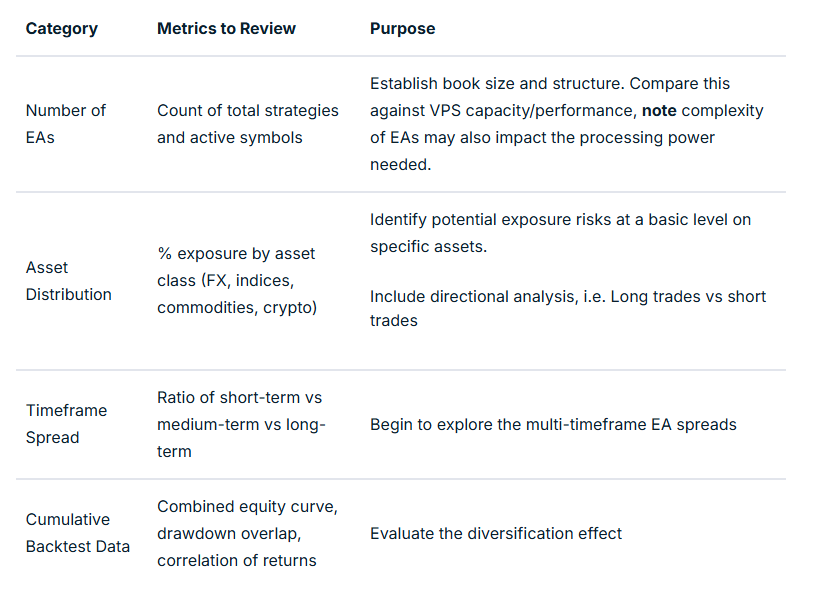
Temporal (timeframe) Balancing
When combined, a timeframe balance (even on the same model and instrument) can help flatten equity swings.
For example, a losing phase in a fast-acting M15 EA can often coincide with a profitable run in an H4 trend model.
Combining this with some market regime and sessional analysis can be beneficial.
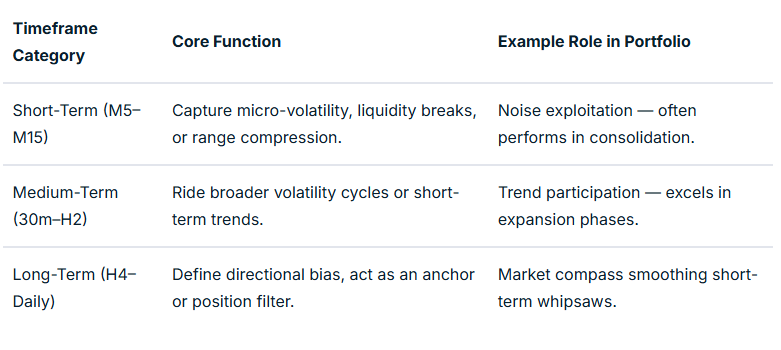
Asset Balance: Managing Systemic Correlation Risk
Running five different EAs on USDJPY might feel diversified if each uses different entry logic, even though they share the same systemic market driver.
But in an EA context, correlation measurement is not necessarily between prices, but between EA returns (equity changes) relating to specific strategies in specific market conditions.
Two EAs on the same symbol might use completely different logic and thus have near-zero correlation.
Conversely, two EAs on a different symbol may feel as though they should offer some balance, but if highly correlated in specific market conditions may not achieve your balancing aim.
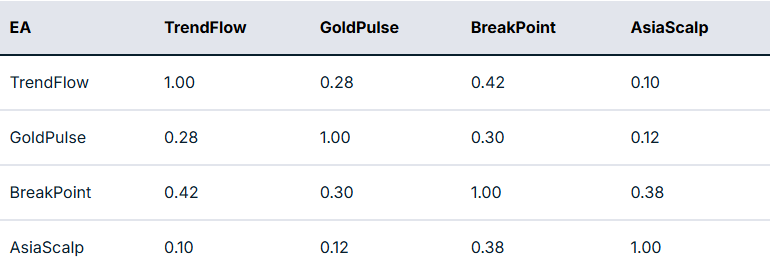
In practical terms, the next step is to take this measurement and map it to potential actionable interventions.
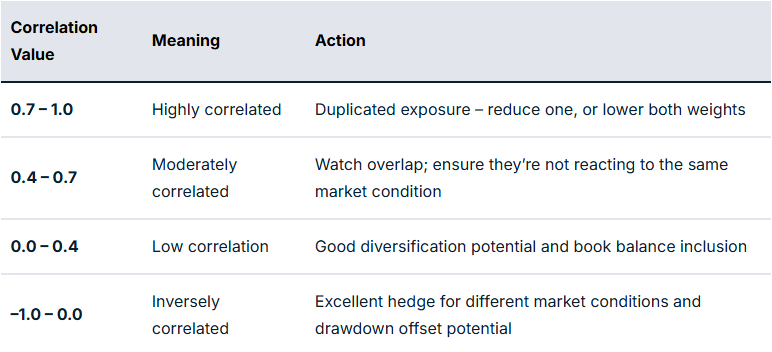
For example, if you have a EURUSD Trend EA and a GBPUSD Breakout EA with a correlation of 0.85, they are behaving like twins in performance related to specific market circumstances. And so you may want to limit exposure to some degree if you are finding that there are many relationships like this.
However, if your gold mean reversion EA correlates 0.25 compared to the rest of your book, this may offer some balance through reducing portfolio drawdown overlap.
Directional and Sentiment Balance
Markets are commonly described as risk-on or risk-off. This bias at any particular time is very likely to impact EA performance, dependent on how well balanced you are to deal with each scenario.
You may have heard the old market cliché of “up the staircase and down the elevator shaft” to describe how prices may move in alternative directions. It does appear that optimisation for each direction, rather than EAs that trade long and short, may offer better outcomes as two separate EAs rather than one catch-all.
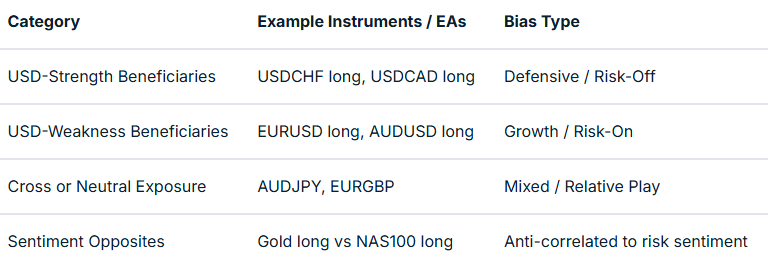
Market Regime and Volatility Balance
Trend and volatility states can have a profound impact on price action, whether as part of a discretionary or EA trading system. Much of this has a direct relationship to time of day, including the nature of individual sessions.
We have a market regime filter that incorporates trend and volatility factors in many EAs to account for this. This can be mapped and tested on a backtest and in a live environment to give evidence of strategy suitability for specific market conditions.
For example, mean reversion strategies may work well in the Asian session but less so in strongly trending markets and the higher volatility of the early part of the US session.
As part of balancing, you are asking questions as to whether you actually have EA strategies suited to different market regimes in place, or are you using these together to optimise book performance?
The table below summarises such an approach of regime vs market mapping:
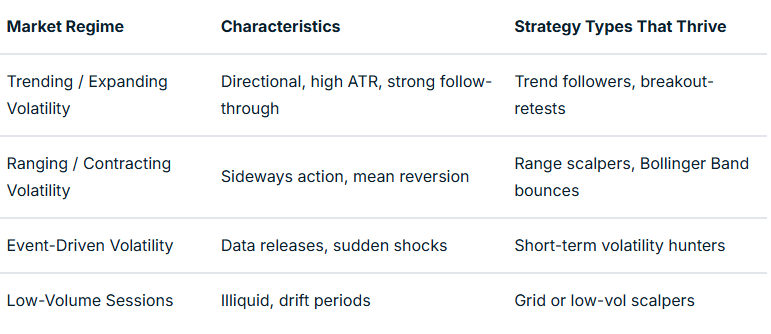
Multi-Level Analysis: From Composition to Interaction
Once your book is structured, the challenge is to turn it into something workable. An additional layer of refinement that turns theory and measurement into something meaningful in action is where any difference will be made.
This “closing the circle” is based on evidence and a true understanding of how your EAs are behaving together. It is the step that takes you to the point where automation can begin to move to the next level.
Mapping relationships with robust and detailed performance evaluation will take time to provide evidence that these are actually making a difference in meeting balancing aims.
To really excel, you should have systems in place that allow ongoing evaluation of the approaches you are using and advise of refinements that may improve things over time.
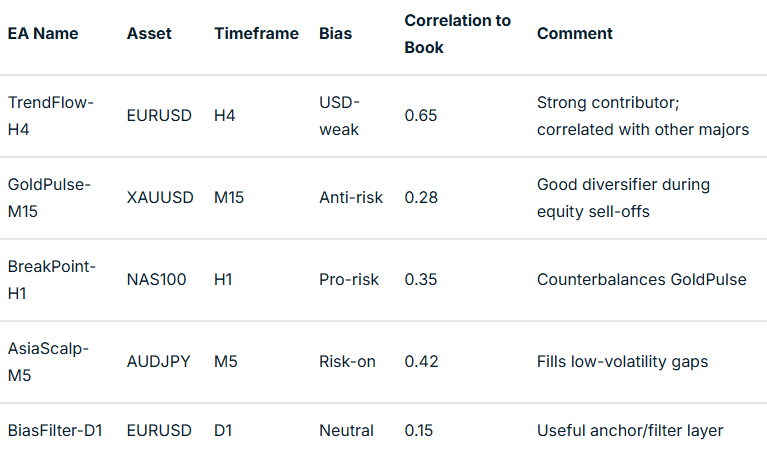
What Next? – Implementing Balance in Practice
Theory must ultimately translate into an executable EA book. A plan of action with landmarks to show progress and maintain motivation is crucial in this approach.
Defining classification tags, setting risk weights, and building monitoring dashboards are all worth consideration.
Advanced EA traders could also consider a supervisory ‘Sentinel’ EA, or ‘mothership’ approach, to enable or disable EAs dynamically based on underlying market metrics and external information integrated into EA coding decision-making.
Final Thoughts
A balanced EA portfolio is not generated by accident; it is well-thought-out, evidence-based and a continuously developing architecture. It is designed to offer improved risk management across your EA portfolio and improved trading outcomes.
Your process begins with mapping your existing strategies by number, asset, and timeframe, then expands into analysing correlations, directional bias, and volatility regimes.
When you reach the stage where one EA’s drawdown is another’s opportunity, you are no longer simply trading models but managing a system of EA systems. To finish, ask yourself the question, “Could this approach contribute to improved outcomes over time?”. If your answer is “yes,” then your mission is clear.
If you are interested in learning more about adding EAs to your trading toolbox, join the new GO EA Programme (coming soon) by contacting [email protected].


Irrespective of what vehicle you are choosing to trade (Forex, CFDs, share CFDs ), position sizing is a crucial part of your trading risk management. It is position sizing, along with effective exit strategies, that have an undoubted major impact on your trading results both now and going forward. At a basic level, the following are part of a position sizing system: a.
Identify a tolerable risk level per trade based on your account size (often 1-3%) meaning you aim to keep any loss sustained within this tolerable limit. b. Using any stop level for specific trades and your tolerable limit to work out how many lots/contacts you can enter to achieve this goal. c. Ensuring you are not inadvertently over-positioning in one market idea (e.g. broad-based USD strength or weakness, by entering multiple trades across currency pairs/ commodity CFDs that will multiply the impact of USD movement).
But what then? How do we explore refining our position sizing to potential optimise results? Here are two initial ideas for potential testing… Idea 1 – Position sizing according to volatility When exploring using volatility for any trading decision it is not just the level but potentially, more importantly, the direction of the volatility i.e. increasing/decreasing.
Volatility is often seen as a reflection of market certainty but perhaps consider volatility as a measure of the likelihood that an asset e.g. Fx pair, is more likely to move away from its current position (and that can be either positively or negatively of course). Logically, therefore, increasing volatility in either direction could represent an increase in risk (and of course visa versa).
Consequently, it is not unreasonable to consider altering your tolerable risk level according to this. So, for example, if your standard is 2% of account capital on any one trade, if you were to implement this as an idea, increasing volatility could mean a decrease in risk level to 1% and decrease to 3%. The challenge, of course, is to determine a method through which you can determine this change.
The ATR is a volatility measure commonly used and would be a potential tool that can assist. Of course, the other aspect is to choose the timeframe to measure this variable. Logically, the shortest timeframe should be the timeframe you are trading but there may be wisdom in looking at longer-term timeframes also.
Idea 2 – Ensure that trail stops account for your tolerable risk level. Arguably a common mistake made by many traders is to view trades on their P/L and make decisions on the fact they are “up” on the deal and as long as the trade is closed before getting back to breakeven then they have a win. An alternative and logically an advanced approach is your net worth in the market is where it is right NOW and hence any pullback in any position is a “loss” from your current place.
This is the rationale behind trailing a stop in an attempt to still have access to the further upside (“letting your profits run”) whilst capping any pullback to a new an improved level to that of your initial stop. There are many ways of trailing a stop e.g. retracement, price/MA cross but again would it not make sense to use your tolerable risk level as part of your trail stop equation. So lets see, for example, use an account size of $10,000 and you are trading a 2% maximum risk level to set your initial stop.
This means that your contract/lot size is based on your technical stop and $200. You have a position that is now up to $350 if you were to adopt this approach when you trail your stop you should ensure that it is placed at a level that would mean that the worst scenario would be that you would close the position at $150 profit. There are of course other advanced position sizing techniques you could test which will be the topic of an upcoming Inner Circle session.
Make sure that you are part of this through registering for these sessions so you can jump on board with this advanced trading education group to access the topics applicable to your trading development. In the meantime, we would be delighted, as always, to hear from you, so if you are using an advanced position sizing technique it would be great to hear from you at [email protected]


Trading Volume: General principles Many experienced traders (even those using a simple system will incorporate volume as part of their entry (common) and/or exit (less common) system. It is essential (as with any indicator) that you understand the role volume can and cannot play with suggestions of what is happening to market sentiment. So generally speaking, trading volume may offer some guidance as to whether market participants are changing sentiment towards the pricing of an asset, and if there is a price move, whether it may have a higher probability in continuing in that trend direction.
Many would consider it more “leading” than the majority of other indicators. Indeed, VSA (volume Spread Analysis) which is based on this principle is an approach used by many. In simple terms, a price move (either way) with higher traded volume is thought to be more robust in terms of trend continuation.
Whereas Lower volume with a price suggests market uncertainty or no interest. Trend reversal and retracement A trend reversal is, as the name suggests, sentiment moving from an established upwards trend to, a new trend forming in the opposite direction e.g. upwards to downwards trend (or visa versa). The risk of remaining in a trade that is reversing is loss of potential profit in that position if one delays exit.
A trend retracement, is a temporary pull back in price prior to continuation of that change in the same direction, often termed a trend pause). The risk of exiting a trade on a retracement is that you are missing out of the additional profit from a subsequent trend continuation move. This differentiation is important when the trader is considering an exit from a specific position.
For example, recognition a reversal from a uptrend to downtrend early would be beneficial when in a long trade. Whereas should the price move be a retracement then to continue to hold that position may prove to have a better outcome as the price subsequently moves higher. The challenge, of course, Is that ability to differentiate and identify through the use of technical “clues” what may be happening to market sentiment.
Is volume the “clue”? If one accepts the premise that level of volume is an indicator in terms of the potential strength of a price move, then can this be a “clue” as to whether the more likely outcome is reversal or retracement? See below for an hourly chart of USDJPY.
We have labelled the confirmed start of trend after a double top type of chart pattern through to the end of the trend and subsequent reversal. Note the lower volume of the two retracements (shown in blue highlight) and the subsequent higher volume as the trend ultimately reversed. In terms of trading actions logically one could consider the following: • Retracements may be a signal to trail a stop loss to the base of the retracement. • Increasing volume may be a signal to exit directly in anticipation of a confirmed reversal.
The Forex Volume Challenge? As many readers will be trading Forex it would remiss of us not to discuss the specific issue briefly with the volume seen on an MT4 platform. With shares (and the volume shown on Share CFD charts for example), the number of traded positions is managed and reported by the central exchanges (e.g.
ASX, NYSE). However, with FX there is no central exchange so the volume you see reflects the trades going through relevant liquidity providers. Additionally, Forex volume on MT4 measures a record of ticks rather than the number of lots traded.
One tick measures a single price change. As a price moves up and down this “tick volume” alters within the specific chart period. On the MT5 platform there is a option to choose so called “real volume” and yet it should still be borne in mind that compared to a stock exchange which theoretically shows all trades from the whole exchange this is not the case with Forex.
Hence, some may question as to whether the measured chart volume with Forex is sufficiently valid on which to make decisions (although theoretically the principle remains the same). The reality… Whatever your thoughts on this, arguably you could question the validity of any indicator. So, ultimately you use the same process for testing and subsequently potentially adding any indicator you may be considering the use of in your individual decision making i.e. back-test to justify a forward test and on evidence decide whether, and how to add volume to your trading decisions.
You challenge is to do the testing, and plant your flag as to whether you are to utilise this in your trading.


A written trading plan, usually comprising of several guiding action statements, serves the following two invaluable purposes: Facilitates consistency in trading action e.g. in the entry and exit of trades, allowing the trader AND Measures the strategy used specified within each statement to make an evidence-based judgement on how well these are serving you and test and amend these statements so you can develop an individual trading plan that may work better for you. Let’s move past the fact that many traders choose not to have a plan at all, an approach that goes against what is one of the key components of giving yourself the chance to become a successful trader, to those who have a plan in place already. This article is targeted a those who have made the logical choice to have some sort of written plan in place.
Great though having a plan is, many traders still have issues with the two purposes outlined above. They still fail to some degree to develop the consistency described and are not really able to measure effectively. A common problem, if we look closely at some of the plan statements used, is that such statement may not be specific enough, have some ambiguity, that means that those purposes may be difficult to achieve.
Let’s provide and work through an example for clarity (we have used something generic that applies to all trading vehicles). Consider the following statement… “I will tighten my stop/trailing stop prior to significant, imminent economic data releases” Firstly, on the positive side again, this does demonstrate an awareness of potential risk and a desire to have something within your plan to manage this risk. However, in terms of being a measurable statement that you can make a judgement as to how well this approach is serving you, there are the following issues: What does ‘tightening’ mean in practical terms in relation to current price point of the chart you are trading?
How close to a data release is ‘imminent’? What constitutes a significant data release (amongst the many that are released daily)? So, to take the previous example consider the following as an alternative: “Prior to imminent economic data releases, I will tighten of a trail stop loss for any open trades, 15 minutes prior to the release and to within 10 Pips of the current price (or course this can be adjusted to points or cents dependent on what you are trading).
This will be actioned for the following data points: Interest rate, CPI, industrial production and jobs data from the country of either currency pair (or Germany, France of across the Eurozone if one of the currency pair is the EURO). US and Chinese PMI manufacturing data, GDP, industrial jobs and interest rate decisions as these may impact all currency majors." So, with THIS amended plan statement the following elements could be measured (if journaled appropriately of course): What would the difference be in your trading outcomes if: No tightening had been actioned. If a different proximity to current price is used e.g. 15 rather than 10 Pips.
If other data releases are added/removed. With this level of measurement, possible with the revised statement, one would now be able to make any changes, backed up with evidence, to your trading plan. Alternatively, of course, you could make the choice to do nothing, retain statements such as the original, and not have the ability to create the richness of evidence to make considered amendments to your plan.
Logically ask yourself the question, "which choice is more likely to serve my trading going forward?"


We have discussed many times the importance of unambiguous, and sufficiently specific statements within your trading plan in previous articles and at the weekly “Inner Circle” webinars (for more information see the Inner Circle in the navigation bar). The benefits of this are twofold: 1. Assist in developing consistency in execution when trading when attempting to follow a trading plan in the “heat of the market” & 2.
Facilitate measurement of aspects of your trading plan to review and refine on evidence. This article aims to give you an example in the context of trailing a stop, one of the key exit strategies employed by traders. Below are some commonly used trading scenarios for trailing a stop, relevant challenges faced when attempting to be appropriately specific within your plan are below.
So, for example, using the first example, we could articulate the statement as follows: "I will check the current 15EMA at the end of every chosen candle chart period for any open position, and trail my stop to this level until the price has crossed below (if long), or above (if short), at which point I will exit the trade". Your challenge is simple. Once you have chosen your trail stop method, review your existing statement and make a judgement and take action if you think you could tighten it up to mean that statement potentially better meets those two aims highlighted at the beginning of this article.


The MACD (or the ‘Moving Average Convergence/Divergence oscillator’ to give its full name) is one of the popular extra pieces of information we often see added to charts. The purpose of this article is to clarify what it may be telling you about market sentiment and offer a description as to how traders commonly apply this in their decision making. This is a slightly lengthier article; brief explanation may not be clear, and we want you to really get to grips with this so you can make the right decisions for you.
Taking a step back. The purpose of technical indicators is to provide the trader with information to assist in entry, or exit, decision making. We have discussed the choice of adding indicators previously and suggested the following: a.
You should not add an indicator unless you understand what it is telling you about market sentiment. b. You should only use any indicator if it provides additional information to that which you have already. To do so may create a more colourful and impressive looking chart but little else. c.
You should always articulate how you are going to use an indicator for entry and/or exit in your trading plan in a specific unambiguous statement to facilitate consistency and measurement. d. There is no point on adding extra indicators if you are not sufficiently disciplined to use the existing plan you have. There is a different priority here you may need to work on if this resonates with you!
In this article we are hoping to add some value in addressing “a” through to “c”. What could the MACD be telling you? The MACD was developed in the 1970’s with the aim of offering information about changes in trend and momentum of a price move.
Additionally, there is a signal line that could assist in pressing the entry/exit button. Despite the somewhat complicated and jargon -filled full version of its title (hence the abbreviation), which unfortunately may put off some inexperienced traders from finding out more before they jump in and blindly use it, when you pick it apart, it is not perhaps as complicated as it may first seem. The indictor is based as the name suggests on using the commonly used and more easily understood moving averages and the principle that if you plot two of these on a chart of different periods e.g. 10 and 20, a cross of these may indicate a change in trend.
Before we move on to looking at the MACD on the MetaTrader platform, it is worth noting that those traders with experience of other software will notice a difference in how the MACD is shown. We will be discussing the MT4/5 version of this indicator as that is the platform that most of you will be using. Before we look at the indicator itself let’s look at a simple chart with two moving averages plotted and explain some of the terms to help explain some of the terminology once we move to the indicator itself.
Here we see a GBPUSD 15-minute chart. There are two exponential moving averages (EMA) namely a 12 and 26 (the reason for this will become obvious in a moment. We see a moving average cross marked; in this case the 26 EMA has moved above the shorter 12 EMA often perceived as indicating a change in trend to the downside.
We also see highlighted in yellow, firstly an example where the moving averages are moving further apart (termed divergence), this is often seen as a signal of increasing momentum as a trend develops. Subsequently, we see highlighted the space between the moving averages narrows (termed convergence). This is often seen as a signal of decreasing momentum and often ultimately results in reversal.
So, back to our MACD, in simple terms, a MACD will give you the same information as above, though admittedly in a different form. Here is the same chart as above but with the MACD added. We have illustrated with the green arrows how the information on the top of the chart relates to the MACD at the bottom.
Now, just to swing back to a point made earlier. The reason we chose the 12 and 26 EMAs on the chart above to help understanding that these are the default settings on a traditional MACD (these are of course adjustable, though most traders wouldn’t choose to do this, nor should without testing). EMA cross and trend direction There is a ‘centreline’ at a zero point on the MACD you can see if there is a cross of the moving averages; the graph also crosses over this line.
If the histogram (the vertical bars) are above the line what this means is that the shorter term (12) EMA is above the longer term (26)EMA. This is indicative of an uptrend. If the vertical bars are below the line, then the longer EMA is on top (see chart above).
Momentum (convergence versus divergence) As referenced earlier in simple terms if the distance between the moving averages is increasing (divergence), this indicates increasing momentum in the trend (and so is thought to be a sign of potential continuation). If you look on the top chart, you will see how this increasing gap is illustrated on the MACD by increasing height of the bars. Conversely, when the moving averages begin to converge (get closer) then length of the bars decreases, this is suggestive of decreasing momentum in the trend which if continues may ultimately result in trend reversal (and a cross of the two EMAs).
On the Metatrader platform the length of the bars in the histogram is a numeric representation of this gap between the two EMAs (12 and 26). It is not unreasonable to question (and many do) that if all this information is on the top chart anyway and easily visible what justification is there to add the MACD box? The signal lines The answer lies in the only new piece of information, that is termed “signal line” as seen on the MACD example above.
The calculation of how this line is plotted is based on taking a simple moving average (SMA) of the difference between the two EMAs. It is seen as potentially important when there is a cross of this line above or below the histogram bar height. The purpose of this line is to potentially give additional information relating to the likelihood of that change in trend momentum and to create a readiness to take action.
To help explain the potential use of this “signal line” let’s use the diagram below which is a “snip” taken from part of the chart as it moves into uptrend. At the start of the uptrend, we see the histogram bar tops over the signal line. As the signal line is a SMA of the height of the bars you note it tracks upwards along with the increased momentum.
Ultimately, as momentum (divergence) begins to “top out”, the height of the bar moves below the signal line. Subsequently, we see a drop-in momentum as the EMAs converge and ultimately the trend ends. Hence, theoretically this could signal a potential reason to exit a trade.
Bringing it all together… Despite the additional “signal” line many questions the usefulness of adding this to decision making processes. However, it remains a popular indicator and as such our advice is, as always, not whether to use or not use it in your system, but rather emphasise the importance of testing your trading system. As with any indicator, general trader consensus is that NO indictor should be used in isolation.
Certainly, there is no information within the MACD that shows whether an asset is overbought or oversold, whether there is associated volume, and of course no accounting for the proximity of key price points (support and resistance), nor the potential impact of economic data. Logic would suggest that all of these are worth consideration alongside the MACD if you are choosing to integrate it within your system. There is some practical use of this that seem odd.
For example, if your “favoured” moving averages on a chart are let’s say 5 and 15 and yet you are using the default 12 and 26 EMAs as part of your MACD set up, this is worth exploring. The fact that much of the MACD information is easily seen on a standard chart is a compelling reason perhaps to test a system with and without MACD and simply look at results. Ultimately, and to finish, it is of course your choice as to which criteria you use.
Remember, whatever these are for you, the key lessons of specifically identifying how you are to use the criteria within your plan, the importance of forward testing (as well as back-testing) of any system change, and of course the discipline of following through are critical whether you use the MACD or don’t.


In a previous article we introduced the SIX steps to improving your trading discipline and offered some guidance on developing “awareness” with a downloadable ‘checklist’ for you to complete. Before we start, If you haven’t seen this article, it is perhaps prudent to go now and complete the checklist as this will inform you for this second step. Click Here The second step has two sub-steps that are critical. 1.
From those areas you have identified in the checklist as requiring work which are the most important to work on. 2. Once you have nailed down your priority area, explore the reason why this may be, to provide you with a focus on what it is you must work on. Prioritise your discipline areas One of the challenges we often face is that if there are several different areas to work on in our development (both in and out of trading), then this can seem very “big” and sometimes overwhelming.
For new or inexperienced traders this feeling of overwhelm may often be a barrier to take any action. So, it seems logical to focus on one issue at a time to make things seem more manageable and achievable. Additionally, and looking forward to later steps, one of the other benefits of this approach is that success in one area will often provide a confidence and the motivation to tackle other areas.
In terms of what we should choose, with the list of areas you will have already identified, there will be some which may potentially have a more easily defined impact than others. An example of this may be that, if you have a trading plan and yet you are consistently failing in executing exits as you should, this would have a major impact on results. So, to the practical aspect once again, with your list, allocate a score between 1-5 re. potential impact you think addressing this area of ill-discipline may have on your results.
This should help you choose the “one”. Identifying the cause. Potential causes of ill-discipline, although sometimes dependent on the situation, can be many.
Here are some of the most common causes (you can get clues from what your internal voice is telling you). 1. A choice that trading is not of enough importance to invest the time/effort needed. (So, “I haven’t got the time”) We all allocate time to trading activities. Such time may be effectively invested in things that could make a difference or otherwise.
Additionally, although we are not suggesting that trading should take over your life, there is a need to ringfence some time (rather than watching reruns of “Law and Order’ to put some hard yards in at the front end to have the right things in place). So, you have two choices to make. a. Do I choose to ensure I have ringfenced the time to do the things I need to become a “committed” trader? b.
Do I choose to ensure that the time I do allocate to trading activities is invested in the right things, e.g. Recording my trades in a trading journal or unfocussed skipping between “interesting” news, or often useless trading forum chatter? 2. Don’t know what to do (or perhaps, “it’s too hard”) OK, so there may be a ‘knowledge gap’ in terms of the “how-to” make something happen.
For example, you may believe that there is merit in making your trading plan statements specific enough to facilitate consistency and measurement, but you are not quite sure where to start. Two key points here... Firstly, as with any part of your trading development planning, you need to refine the question you are asking, then seek out appropriate resources and of course finally to follow through on asking for what you need.
GO Markets has platform support and educational support to help you on your journey. Perhaps you are not asking as you feel you should already know the answer or maybe even that you think your question may be “stupid”. Remember there is no such thing as a stupid question, and surely it is far less wise not to ask if the support is there.
Secondly, sometimes when faced with multiple issues to resolve it may seem overwhelming or perhaps taking on new knowledge is something that does not come easy. Think about your journey so far. I am sure there are things which you didn’t know at one stage that now come easy.
Why shouldn’t additional learning be the same? Quite simply, you must step up to the plate and find the answers you need. 3. You have not been specific about what you should do and when you should do it Ambiguity in a trading plan or system is one of the potentially most damaging issues on an on-going basis.
We frequently extol the virtues of having enough specificity in all your trading plan statement to facilitate consistency in action and the ability to measure your trading actions accurately and meaningfully (so as to make adjustments if needed). To remain in a state of uncertainty in action as you have not got sufficient and specific individual guidelines to use in the “heat of the action”, clearly does not serve you well from a discipline perspective. Additionally, it may be that your trading plan is incomplete.
Perhaps it does not cover all market scenarios or may have enough detail regarding trade entry but lacks the same rigor relating to exits. The solution here is obvious. Work need to be put in to make your trading plan as robust and specific as it needs to be.
We have written a previous article on this, so if this resonates with you then perhaps this would help (Insert link). 4. Don’t believe something/you will make a significant difference e.g. your existing system, a new system, a new piece of learning. Clearly if you have little faith that a particular action, be it part of your trading plan or the need to implement a system such as journaling, is going to make a difference to your trading results, then you are far less likely to action.
Adult learning theory is full of references to the need for relevance before learning action is taken and of course much of this is based on having some evidence that something will make a difference. Here is the problem, without evidence of at least some tangible difference you are less likely to act and yet without action you are not going to create the evidence you be sufficiently motivated to do something. We are going to discuss gathering evidence in detail in other articles within this series but for now it is probably sufficient to say, that if the only way to create the evidence that something will work for you then surely it is worth even dipping your toe in the water to find out a little.
This may be enough to give you the will to subsequently try something out for longer. 5. In-built trading ‘heuristics’ (cognitive biases) or a belief that the market is “wrong”. Our final point of the common fives is some of the in-built “wiring” you may have.
People who come to trading have an inbuilt set of belief and value systems that develop through their lives through instruction from others and experience. These inbuilt systems are termed cognitive biases, and in many instances in the ‘heat of the action’ take over from your written and planned ‘trading system’, even if you strongly believe that your system is good, influence on your behaviour in the market. Results that you may produce from your trading can reinforce these inbuilt biases making them more acute, and so have more and more influence on what you may do when in the market, until finally they end up destroying the capital and so confidence of the investor.
There are many such biases documented in an area of study termed behavioural finance. Six of these seem to be commonly described namely: • Loss aversion bias, • Recency bias, • Outcome bias, • Sunk cost effect, • Minimalisation, & • Disposition bias. We will explore these in detail in future articles, but these may be a contributory root cause particularly of execution discipline with direct trading action.
So, with our five root causes covered, onto your missions for this second step (key question…Are you going to push through an exercise the discipline to follow through?): Consider the potential causes (listen to your internal voice) and begin to identify what cause(s) may be relevant for you. Make notes on anything you identify to get more detail “inked” on paper. Watch out for the next article in this series where we will explore starting to gather enough evidence to change potentially ill-disciplined behaviour into actions which may serve you well.

